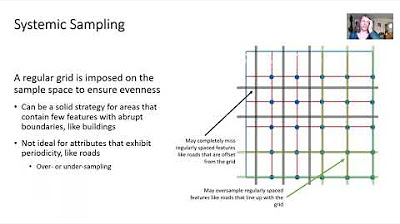Segment 4 of 9: Monitoring Tigers - Line Transect PART 2
Summary
TLDRThis video explains the process of line transect sampling, a method used to estimate prey animal density in large forest areas. The procedure involves a two-person team walking at a uniform pace, silently scanning the surroundings, and measuring distances to animals using rangefinders and compasses. Data, including animal counts and distances, are carefully recorded for analysis in specialized software. Key factors include walking during optimal hours, using multiple transects for accurate results, and ensuring safety while handling potential dangers in the forest. The method is crucial for wildlife monitoring and understanding animal populations in diverse habitats.
Takeaways
- 😀 Walking on a transect requires care and practice, with a team of two people walking silently at a uniform pace of 1.5 to 2 kilometers per hour.
- 😀 The person walking in front scans the area ahead, while the person behind scans the area not covered by the first person.
- 😀 When animals are spotted, observers must quickly identify, count, and measure the distance to the animals using a rangefinder.
- 😀 It's crucial to measure the exact distance from the transect line to the animals, as any errors will affect the results.
- 😀 To measure the perpendicular distance, observers must also carry a compass and take a bearing of the animal's position relative to the transect line.
- 😀 For groups of animals, measurements should be taken from the center of the group.
- 😀 If animals have moved from their original position, the measurement should be taken from the first spotted location, not the new position.
- 😀 All data, such as animal count, distance, and compass bearing, must be accurately noted in the datasheet.
- 😀 Observers must not linger while watching animals and must move on as soon as data collection is complete.
- 😀 The best time for transect surveys is early morning and late afternoon, especially during the dry season after rain showers, when visibility is better.
- 😀 Transects are usually 3-4 kilometers long, and multiple transects (ideally 20-40) are necessary to sample the entire habitat for accurate estimates.
Q & A
What is the ideal pace for walking on a transect line?
-The ideal pace for walking on a transect line is between 1.5 to 2 kilometers per hour.
How should the observers be positioned during a transect survey?
-The team should consist of two people: one walking ahead to scan the area in front, and the other walking behind to scan the area not covered by the first observer.
What measurements must be taken when animals are spotted during a transect survey?
-When animals are spotted, the distance from the observer to the animals and the angle of the animal's position in relation to the transect line must be measured.
Why is it important to measure the exact distance to the animals from the transect line?
-Measuring the exact distance is crucial as any mistakes in measurement will alter the accuracy of the results and affect the final analysis.
How should the perpendicular distance from the transect line be calculated?
-The perpendicular distance is calculated using the measured distance and the compass bearing, which allows the calculation of the exact distance in relation to the transect line.
What should be done if animals have moved since being first spotted?
-If the animals have moved, the measurement should always be made to the point where the animals were first spotted, not their new position.
What should be done if there is a group of animals?
-If there is a group of animals, the distance measurement should always be made to the center of the group or herd.
When is the best time of day to walk on a transect line?
-The best times of day to walk on a transect line are during early morning and late afternoon hours when prey animals are most active.
What is the ideal season for conducting transect surveys?
-The best season for transect surveys is the dry season, as visibility is better, and the forest is more open. It is even better after a few rain showers to reduce noise from leaf litter.
What is the typical length of a transect line?
-A typical transect line is usually 3 to 4 kilometers in length.
How many transects should be conducted for accurate data collection?
-Ideally, between 20 to 40 transects should be conducted to sample the entire habitat and ensure accurate data collection.
How is the data from a transect survey analyzed?
-The data collected during a transect survey is analyzed using a software program called 'Distance', which generates estimates for prey animal density.
What safety precautions should be taken during a transect survey?
-Field workers should take common-sense precautions due to the presence of dangerous animals in Asian forests, such as carrying appropriate safety equipment and being alert at all times.
Outlines

This section is available to paid users only. Please upgrade to access this part.
Upgrade NowMindmap

This section is available to paid users only. Please upgrade to access this part.
Upgrade NowKeywords

This section is available to paid users only. Please upgrade to access this part.
Upgrade NowHighlights

This section is available to paid users only. Please upgrade to access this part.
Upgrade NowTranscripts

This section is available to paid users only. Please upgrade to access this part.
Upgrade Now5.0 / 5 (0 votes)





